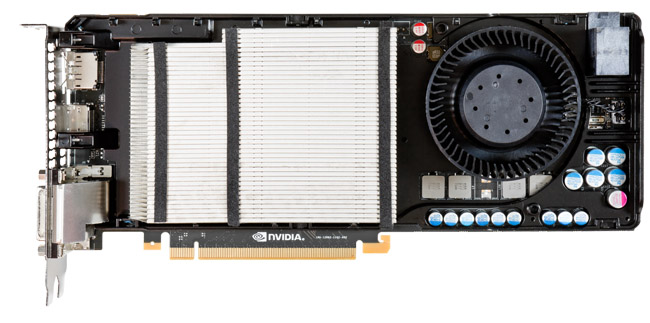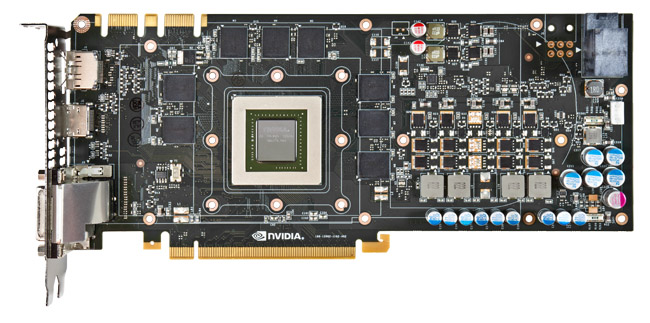The reference card examined
And here is the GeForce GTX 680 2GB card in regular NVIDIA livery. The card's look and feel is much like a GeForce GTX 580's, yet it's a little shorter, measuring 10in compared to the erstwhile champ's 10.5in. It tips the scales at 805g, or 85g lighter than the card it replaces as single-GPU head honcho in NVIDIA's GeForce line.
Take a gander at how the two 6-pin power connectors are arranged. They're stacked on top of each other in a rotated fashion, meaning the power supply's plugs face each other. NVIDIA says this stacking design saves PCB space that can be better used to direct cooling for the radial fan.
Whatever the practicalities of stacking PCIe connectors, whether you like it or not, it provides for some neat cabling in a chassis. Like other premium NVIDIA cards before it, GTX 680 has two SLI fingers. Those feeling flush can invest in three or four cards.
Here's one genuine improvement over all older GeForce cards. Two dual-link DVI, HDMI and DisplayPort outputs can all be used concurrently, enabling four-screen gaming from one card. We like the fact that both DVI and the HDMI can be used without the need for any special adapters. What's more, read the architecture section and you'll appreciate that NVIDIA's drivers also include support for 3D Vision Surround, as well.
Take away the shroud and the radial fan and vapour-chamber cooling, complete with internal heatpipe, come into view. Cooling a 195W TDP card isn't difficult, though it's worth recalling that, now, TDP is produced from a much smaller die than on first-revision Fermi. This means the heat is concentrated, for want of a better explanation, and the cooler needs to be up to the task, more so if users increase the power threshold in the control panel. Also note that having side-by-side 6-pin connectors wouldn't work on this PCB.
Strip it all away and the bare PCB comes into view. Hmm, the card has another 6-pin PCIe connector silkscreened but not used. Perhaps the cooling was changed at the last minute and the stacking connectors were born. What's your guess for the presence of this potential connectors?
Looking a little different from a GTX 580, the whole card feels more AMD in design. Some PCB space has also been made available by using a 256-bit memory bus - one only needs eight chips instead of the 10 found on ye olde GTX 580.
The reference card is simple, elegant and well-built. Partners are sure to run with this for the first batch of cards, and the holes surround the GPU suggest that partners can use GTX 580/570 coolers without the need for modification unless they want to concurrently cool the memory chips; they're in a different position.















